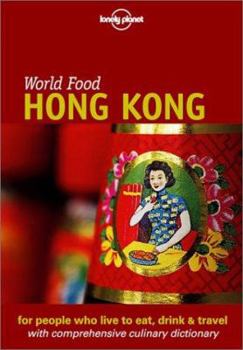Lonely Planet World Food Hong Kong
(Part of the Lonely Planet World Food Series)
A pocket-sized guide to the culture of eating and drinking in Hong Kong. It includes a chef's culinary dictionary and insider's guides to eateries, markets and home cooking in this vibrant... This description may be from another edition of this product.
Format:Paperback
Language:English
ISBN:1864502886
ISBN13:9781864502886
Release Date:January 2001
Publisher:Lonely Planet
Length:270 Pages
Weight:0.70 lbs.
Dimensions:0.6" x 4.6" x 6.5"
Customer Reviews
3 ratings
Eating in Hong Kong
Published by Thriftbooks.com User , 17 years ago
Last year when we headed out to Hong Kong, I was surprised to see this food guide. Since I am very familiar with Cantonese food, I was interested to see how Hong Kong might differ from New York City, Los Angeles, or Vancouver. This guide was incredibly helpful in describing not only the different foods available in different areas but the customs of eating and what we would see. Where my husband has often considered hotel food to be surprisingly mediocre, in Hong Kong, we were told to go to hotel restaurants. The rent is so high that the restaurant's in hotels essentially are subsidized for their space and therefore some of the best dining experiences can be found in hotels. But I digress. This is not an expensive guide and definitely worth the money for the amount of familiarization it provides.
a helpful and fun book, even if u dont plan adventure-eating
Published by Thriftbooks.com User , 21 years ago
... This is an informative and enjoyable book, and lets you delve into Hong Kong culture and eating culture in a way the other books don't. The inside cover has a quick reference of several Cantonese terms in English and Chinese characters, including counting numbers and the very important "ngoh5 hei6 sou3 xig6 ge3" (I am a vegetarian). The book closes with over 50 pages of Cantonese phrases (including "I am ill", "I am pissed", "I want to throw up", and "Thank you, that was delicious"; a glossary of foods and terms; and a Hong Kong culinary dictionary (explains the main ingredients and cooking method). Each transliterated word is coded with the proper intonation, distilled into 6 basic tones. There are 200 beautifully photographed pages of places to eat (from concept to neon to mobile dai pai dong, to street restaurants); a discussion of the banquet; and analyses of staples, such as soups and noodles, rices and meats, and sauces. There are sections on shopping, picnics, utensils, medicinal foods, and "chinese table rules" (no vertical chopsticks please).
Lonely Planet World Food Hong Kong
Published by Thriftbooks.com User , 22 years ago
Back in 1991 I set off for a twelve-month global journey. With me I had a few essentials, money, clothes, my wife and a collection of Lonely Planet Travel Guide Books. After a few weeks in India we found that the books were as essential to our survival as food and water. We went on to use the Lonely Plant Guide Books (or the LP as we termed them) though out Asia, Australia, New Zealand, Hawaii, North American, Canada and Mexico. Sometimes our travels would be so fast and furious that we would not read about our next destination until we had arrived the town's bus depot. We grew to love and trust the LP - it never let us down. As you might imagine I was therefore thrilled to receive their latest departure in to travel writing "World Food Hong Kong ". Furiously I dived in to its pages. When I saw that pocket size book was written by Richard Sterling a guy who would - quote " go anywhere and court any danger for the sake of a good meal" I new I would be in for an interesting literary adventure.Richard Sterling's other titles include; Dining With Headhunters; The Fearless Dinner; and the award wining Travelers' Tale. His much-applauded writing has won him praise from The James Beard Foundation and kudos from the Lowell Thomas awards.The book 's contents are broken down fourteen chapters -World Food Hong Kong starts with the essential aspect of understanding the domains cuisine culture. Sterling enlightens us on the island's history, flavors and influences. My learning began. It would seem that Hong Kong's cuisine is a melting pot of the nations tastes with the addition European influences; olive oil, ketchup and asparagus all worked themselves in to the fabric of the island's "local" cooking.Staples and specialties are next; rice, noodles, tofu, meat, sauces flavorings - the list continues as do the lessons. We all know that in 1295 Marco Polo introduced the noodle to Italy but did you know he made his mark on the Chinese too; he introduced the kiss? The content continues with Drinks, Home Cooking, and Celebrating with Food. Food as Medicine is where I must pause to narrate. Sterling reminds us that the Chinese believe that "food, medicine and health are all part of the same continuum. This is derived from the Chinese philosophy of Yin and Yang, which applies as much to human health as it does to the cosmos. When all in the universe is in its proper balance, harmony reigns. But in a condition of imbalance, we risk ill health, misfortune violence and destruction. Lesson: Seek balance!" If you are seeking balance try the Yin Yang soup or if you are feeling peaky there is always the Lizard soup chicken and cloud fungus.Seeking knowledge of unusual foods? Then move to the next chapter "The Bold Palate". These are foods for the brave. How about preserved eggs, snake or baby mouse wine? That is right the wine is made by preserving still-suckling baby mice in rice wine. Apparently this is jolly good for rejuvenating the body's organs. For those who have sur




